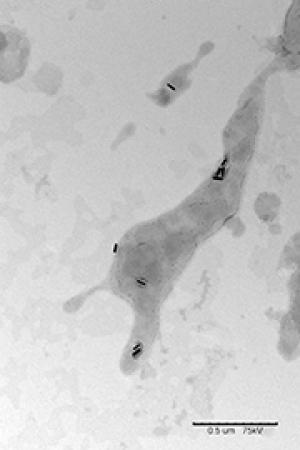|
Thought those $150 brand-name sneakers helped improve your running form? Think again.
Nature has recently published research that undermines the idea of preventing injuries with fancy footwear. Based partly on the American Academy of Physical Medicine and Rehabilitation’s finding last December that running shoes negatively impact hip, knee, and ankle joints, the study determined that runners with shoes tend to land on their heels rather than the middle/front parts of their feet, as early Homo Sapiens. Specifically, the cushioned soles of running shoes allow for a collision force at least 1.5 times body weight. This change from the evolutionary norm of barefoot running can lead to potential injuries of the feet and legs. According to Daniel Lieberman (human evolutionary biology professor at Harvard University and lead author of the study), “most people today think barefoot running is dangerous and hurts. But actually you can run barefoot on the world’s hardest surfaces without the slightest discomfort and pain.” He also adds for uneasy runners, “all you need is a few calluses.” Or perhaps invest new running gear, such as Newton Running shoes or the Vibram Five Fingers to readjust the stride and landing position. Regardless, runners should focus on maintaining good form (i.e. what has developed over thousands of years) with or without shoes. Good luck on the road! -GTB
0 Comments
Recently, Bell Labs formed a group of networking and computing firms called “Green Touch.” The group’s life-changing mission? By the year 2015, use only a ten-thousandth of the energy necessary to power global telecoms network today. To put things in perspective, this enormous amount of energy saved prevents 300 million tons of carbon dioxide emissions into the atmosphere.
Only using 1% of the energy we use today by 2015 seems like a huge task. But engineers at AT&T, Stanford University, MIT, Samsung, and other research centers or mobile operators are making progress towards that ambitious goal. Bell Labs is progressing on research regarding the capturing of signals from loud “noise” more efficiently through “smarter” coding. Rod Tucker of the University of Melbourne plans to focus on developing a “sleep mode” for broadband modems, saving packets of energy. Young Mo Kim of Samsung takes a different approach in emphasizing changes to memory and display capabilities of hardware. Jeong Kim of Bell Labs introduces even another tactic to save a whole lot of energy: encourage cellphone users to utilize their cellphone batteries in a more efficient way. In 2007, scientists predicted that global warming would advance at an increased rate in 2009. With the Kyoto Protocol’s run ending in 2012, and the recent Copenhagen Climate Conference (2009) ending with few immediate signs of radical global warming prevention measures, perhaps “Green Touch” can save the Earth, one ton of carbon dioxide emissions at a time. GTB Millennia ago, Egyptian and Roman women used lead-based face creams and suffered terrible skin complications. You think lead-contaminated cosmetics is a thing of the past? Not at all. In October 2007, the Campaign for Safe Cosmetics found that 61% of the 33 lipsticks tested contained lead with levels ranging up to 0.65 parts per million.
Even more frightening are toxic chemicals such as formaldehyde, phthalates and toluene common found in nail polishes. Phthalates have been reported to affect hormone levels and are especially dangerous for pregnant women. Toluene can cause developmental problems for fetuses. Face powders contain titanium dioxide, a carcinogen. Since the skin is a porous organ, the products are absorbed by the body and can lead to health issues. Unsafe cosmetics is a growing issue because according to the FDA, an average American uses 10 different cosmetic products (hairspray, shampoo, makeup, lotion, and even soap) a day. The cosmetics industry must comply with FDA safety requirements but the multi-billion dollar industry is too expansive for the government agency to enforce the regulations. When a product first hits the shelves, it has not been tested or approved by the FDA. It is only when complaints are filed that the FDA investigates the product and decides whether or not to ban it. The process takes time and many users could be affected before the FDA removes the products from the shelves. Another problem is the inadequate labeling. Companies are required to state the ingredients but sometimes instead of listing all of the synthetic chemicals contributing to the scent of perfumes, they simply list “fragrance.” Carmine is an insect extract that provides splashes of color to makeup and is usually listed as “color added.” Recently, the FDA concluded that carmine is a common allergen and must be listed on labels. So before we are fooled by clever marketing and products that promise the stars and moon, remember to exercise caution. Let the user beware. For detailed information visit: http://www.scientificamerican.com/article.cfm?id=how-safe-are-cosmetics&page=3 http://www.safecosmetics.org/index.php ~HW Many of us would agree that surgery is not the most pleasant experience. Open heart surgery? Not only is this surgery unpleasant but is also one of the more dangerous surgical procedures. For those individuals with mitral valve regurgitation, a condition in which a dysfunctional, weak mitral valve allows a backflow of blood to the heart, there is another choice: the Mitra Clip.
The Mitra Clip procedure, though still undergoing clinical trials, has dramatically reduced the time necessary for recovery in comparison to open heart surgery. In a two-hour undertaking, cardiologists insert the clip through a catheter from the groin – specifically, the femoral artery – to the heart. At the heart, the clip restricts the loose valves and prevents unnecessary movements of blood in the heart. Patients who have undergone the Mitra Clip procedure have reported relief from symptoms such as “fatigue, exercise intolerance, shortness of breath and swelling” (George Hanzel, M.D.). For those with a weak heart, this alternative to open heart surgery could be a lifesaver. -GTB George Bernard Shaw once said that “We are all dependent on one another, every soul of us on earth.” The Irish writer might not have had nanomaterials in mind then. However, chemists, bioengineers, and cell biologists at MIT, UC Santa Barbara, and UC San Diego have recently developed a mixture of nanomaterials that work together to kill cancerous tumors. Separately, these nanomaterials either fulfilled the purpose of staying long enough in the bloodstream to identify tumors or stick to tumors, but never both. Applying the concept of using a cocktail of drugs to amplify the destructive effect on a single aspect of a disease, the researchers mixed gold nanorod particles and either iron oxide nanoworms or doxorubicin-loaded liposomes. The gold nanorod particles in blood vessels identify the tumor by taking up infrared laser irradiation from a weak laser beam; afterwards, the iron oxide nanoworms or doxorubicin-loaded liposomes specifically target the heated tumor.
Michael Sailor at UC San Diego put it this way: “Think of them like soldiers attacking an enemy base.” The gold nanorods are the Special Forces, who come in first to mark the target. Then the Air Force flies in to deliver the laser-guided bomb. The devices are designed to minimize collateral damage to the rest of the body.” This innovative cocktail of nanoparticles was shown in this study to be successful for mice with epithelial tumors. Hopefully, this collaboration of nanomaterials will be applied to quickly detect tumors with MRI in other live animals and thus dramatically reduce the size of tumors. There is truly value in cooperation, yes? GTB |
Categories
All
Archives
April 2024
|





